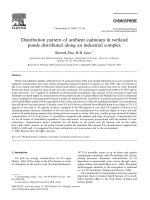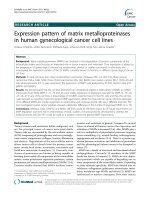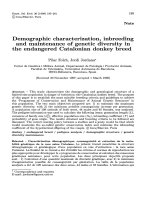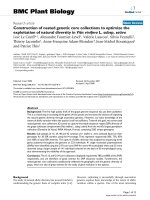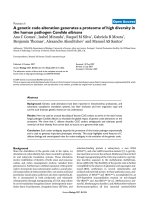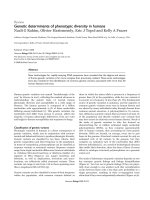Pattern of genotypic diversity in indigenous castor (Ricinus communis L.) genotypes
Bạn đang xem bản rút gọn của tài liệu. Xem và tải ngay bản đầy đủ của tài liệu tại đây (168.49 KB, 7 trang )
Int.J.Curr.Microbiol.App.Sci (2019) 8(1): 2465-2471
International Journal of Current Microbiology and Applied Sciences
ISSN: 2319-7706 Volume 8 Number 01 (2019)
Journal homepage:
Original Research Article
/>
Pattern of Genotypic Diversity in Indigenous
Castor (Ricinus communis L.) Genotypes
J. Jawahar Lal* and C. Lavanya
ICAR-Indian Institute of Oilseeds Research, Rajendranagar, Hyderabad-30, India
*Corresponding author
ABSTRACT
Keywords
Cluster, D2, Genetic
diversity,
germplasm, PCA
analysis, Castor,
Variability
Article Info
Accepted:
17 December 2018
Available Online:
10 January 2019
Castor genotypes (30) were evaluated for ten yield and yield attributing characters to study
the genetic diversity existing among them by using Mahalanobis D 2 statistics. Analysis of
variance revealed significant difference among genotypes for all the ten character studied.
Based on the D2 values the genotypes were grouped into six different clusters. Maximum
inter cluster distance was observed between III and VI (6170.49) while, lowest divergence
was noticed between clusters I and II (742.33) indicating close relationship and similarity
for most of the traits of the genotypes in this cluster. Among the nine clusters studied,
yield at 180 days contributed highest towards genetic divergence (48.74%). Principal
component (PC) analysis revealed that first three PC axes explained 72.48% of the total
multivariate variation while the first five PC axes explaining 88.94%. These results have
an important implication for castor germplasm characterization, improvement, agro
morphological evaluation and conservation.
Introduction
Castor is a member of the Euphorbiaceae
family that is found across all the tropical and
semi-tropical regions of the world (Weiss,
2000). Castor is one of the ancient and
important non-edible oilseeds that has
immense industrial and medicinal value.
Castor is an ideal candidate for production of
high value, industrial and oil feed-stocks
because of the very high oil content (48-56%)
of the seed. Castor oil is used in more than
700 industrial products and its demand is
increasing by 3-5 percent per annum (Anjani
2012). India is the largest exporter of castor
oil in the world market. Castor plant has
unique ability to produce oils with extremely
high levels of ricinolic acid (80-90%)
(Brigham, 1993; Hegde and SudhakaraBabu,
2002). Historically, commercial production of
castor has been limited by concerns about the
toxins found in castor seed, unstable global
market for the oil and lack of efficient
technologies to produce and process the crop
(Brigham, 1993). The ultimate goal of any
plant breeding programme is to improve plant
traits for agronomic and economic
superiority. Genetic improvement of castor
has the potential to overcome many
production constraints. Genetic diversity in
crop plants is essential to sustain level of high
productivity (Rabbani et al., 2010). It is an
2465
Int.J.Curr.Microbiol.App.Sci (2019) 8(1): 2465-2471
established fact that, genetically diverse
parents result in desirable gene combinations
and produce high heterosis. Earlier,
geographical diversity has been considered as
a remarkable index of genetic diversity (Joshi
and Dhawan, 1966). The choice of suitable
parents is of paramount importance for a
planned
and
successful
hybridization
programme. Hence, efforts have to be made to
identify the best parents with wide genetic
divergence from germplasm pool for the
characters of economic importance, so as to
utilize them in hybridization programme.
Materials and Methods
The present study was conducted at the
research field of Indian Institute of Oilseeds
Research, Narkhoda farm, Hyderabad. The
experimental material for the present study,
comprised of thirty genotypes of castor
procured from castor AICRP centre, Junagadh
Agricultural University, Junagadh and S.D.
Agricultural university, S.K.Nagar. The
experiment was laid out in a randomized
complete block design replicated thrice. Each
genotype in each replication was sown by
dibbling the seeds in two rows of plot 6 m
length, with a spacing of 90 cm between the
rows and 60 cm between the plants. The
recommended packages of practices were
adopted to raise a healthy crop. Ten randomly
selected plants from each plot per replication
were scored for recording observations on 10
metric traits viz., days to 50% flowering, days
to maturity, plant height (cm), number of
nodes to primary spike, total length of
primary spike, effective length of primary
spike, total spikes per plant, 100 seed weight,
oil content and seed yield at 120, 150 and 180
days. The mean of ten plants for all the
characters, except days to 50% flowering and
days to maturity was utilized for carrying out
statistical analysis. For days to 50% flowering
and days to maturity was recorded on plot
basis. Multivariate analysis was done as per
Mahalanobis D2 statistics described by Rao
(1952) and the grouping of genotypes into
different clusters was done according to
Tochers method. The data were subjected to
principal component analysis (PCA). PCs
with Eigen values >0.5 were selected, as
proposed by Jeffers (1967).
Results and Discussion
The analysis of variance revealed highly
significant differences among the 30
genotypes for all the characters indicating
considerable genetic variation in the material
studied (Table 1). A wide range of variation
for agronomic parameters in castor was
reported by Anjani (2000) and Anjani (2012).
It was possible to group the examined castor
genotypes into six different clusters (Table 2).
Cluster I with seven accessions, Cluster II and
VI each with four accessions respectively.
Cluster IV was constituted by twelve
accessions. Cluster V contains two genotypes.
The pattern of group constellations proved
that significant amount of variability existed.
This is an indication for the absence of
relationship between genetic diversity and
geographic diversity. Similar results have
been reported by Bhatt and Reddy (1987),
Ramesh et al., (2012) and Chavan et al.,
(2012).
Based on values of inter cluster distance
(Table 3), it was found that the highest
divergence occurred between cluster III and
VI (6170.49) followed by cluster I and VI
(4602.67), indicating the wider genetic
diversity between genotypes of these groups.
The cluster III involved accession of DCS107 variety which high yielding, cluster II
involves accessions of pistilate lines M-574,
DPC-9 which are cross derivatives of other
geographically diverse accessions as per the
catalogue of castor germplasm indicating
genetic diversity being contributed by
geographical diversity or cross combinations
2466
Int.J.Curr.Microbiol.App.Sci (2019) 8(1): 2465-2471
involving geographically diverse genotypes.
This was in contradiction to studies like
Chakrabarty and Banu (1999), and Singh and
Srivastava (1978) in castor. Hence, selection
of parents from these clusters for
hybridization programme would help in
achieving novel recombinants. On the other
hand, the lowest divergence was noticed
between clusters I and II (742.33) indicating
close relationship and similarity for most of
the traits of the genotypes in this cluster. The
inter cluster distance was higher than the intra
cluster distance Ramesh et al., (2012) which
indicates the existence of substantial diversity
among the genotypes.
The characters contributing maximum to the
divergence need greater emphasis for
deciding on the clusters for purpose of further
selection and choice of the parents for
hybridization. The highest contribution (Fig.
1) in this regard was made by seed yield at
180 days (49%) by ranking 212 times first
ranking followed by seed yield at 120days
(20%). These results are in conformity with
the findings of Sudhakar et al., (2006) and
Ramesh et al., (2012). Based on the inter
cluster distances, the genotypes JI-226, JI-
227, JI-244 and SKI-301from cluster I, M574 and DPC-9 from cluster II, M-571, VP-1
and JI-340 from cluster IV, Geetha and JI-322
from cluster V were selected for hybridization
programme as they are expected to produce
high heterotic crosses.
Multivariate analysis of the accessions
revealed that the first five PCs (PC1 to PC5)
gave Eigen-values > 0.5 and cumulatively
accounted for 88.94% of the total variation
(Table4). The cumulative proportion of the
variation reached 72.48% in the first three PC
axes, and 88.944% in the first five axes. The
high degree of variation in the first five PC
axes indicates a high degree of variation for
these characters.
There are no guidelines to determine the
significance or importance of a coefficient,
that is, Eigen-vector. However higher
coefficients for a certain trait indicate the
relatedness of that trait to respective PC axes
(Seymus Furat and Bulent Uzun, 2010).
Characters with high coefficients in the PC1
to PC4 should be considered as more
important since these axes explain more than
half of the total variation (Fig. 2).
Table.1 Analysis of variance for eleven characters in 30 genotypes of castor
S.
No.
1.
2.
3.
4.
5.
6.
7.
8.
9.
10.
11.
12.
Character
Days to 50% flowering
Days to maturity
Plant height (cm)
Number of nodes to primary Spike
Total primary spike length
Effective primary spike length
Total spikes/ plant
100 seed weight
Yield 120 DAS
Yield 150 DAS
Yield 180 DAS
Oil content %
Mean sum of squares
Replications
Treatments
(df = 2)
(df = 29)
0.02
27.13**
0.02
105.33**
1.19
600.95**
1.93
15.37**
2.69
100.42**
25.22
132.53**
6.80
19.44**
1.7923
43.76**
21.84
2203.08**
26.21
1562.69**
1.90
3707.05**
0.02
16.80**
* Significant at P = 0.05 level
** Significant at P = 0.01 level
2467
Error
(df=58)
0.36
0.53
25.29
0.54
21.27
23.16
5.43
1.22
15.31
17.45
17.09
0.76
Int.J.Curr.Microbiol.App.Sci (2019) 8(1): 2465-2471
Table.2 Distribution of thirty genotypes of castor into different clusters
Cluster
number
I
II
III
IV
Number of
genotypes
7
4
1
12
V
VI
2
4
Genotypes
JI-244, DCS-94, JI-226, JI-227, 48-1, JI-338, SKI-301
SKI-215, M-574, DPC-9, Haritha
DCS-107
SKI-291, DCS-84, Kranthi, DCS-9, M-571, DCS-81, JI-340, JI319, SKI-294, JI-315, DCS-89, VP-1
SKI-232, SKI-283
Geetha, SKI-304, DCS-86, JI-322
Table.3 Intra (diagonal) and intercluster average of D2 and D values of thirty genotypes of castor
Cluster
Number
I
263.14
II
III
IV
V
VI
742.33
4073.00
1109.33
2963.40
4602.67
336.95
2367.92
1174.36
1632.34
4413.12
0
4595.83
3451.37
6170.49
690.52
1683.64
2595.09
682.22
3274.53
I
II
III
IV
V
1078.52
VI
Table.4 Percentage and cumulative variances and Eigen-vectors on the first five principal
components for each character in 30 castor accessions
Parameters
Eigene values (root)
% Var. Exp.
Cum. Var. Exp.
Variables
Days to 50% Flowering
Days to Maturity
Plant Height
No.of Nodes to Primary Spike
Total Length Primary Spike
Effective Length Primary Spike
Total Spikes/ Plant
100 Seed Weight
Yield 120 Days
Yield 150 Days
Yield 180 Days
Oil Content %
PC1
PC2
5.31
1.88
44.23
15.64
44.23
59.87
Eigen vectors
0.37
0.18
0.40
0.20
0.27
-0.09
0.21
-0.17
0.17
-0.06
-0.37
-0.17
0.41
0.12
0.32
0.16
0.24
-0.25
-0.20
0.58
-0.12
0.65
-0.21
-0.05
2468
PC3
1.51
12.61
72.48
PC4
1.25
10.38
82.86
PC5
0.73
6.09
88.94
0.04
0.03
-0.45
-0.17
0.35
-0.21
0.03
-0.25
-0.43
-0.16
-0.16
-0.55
0.06
0.07
-0.18
-0.64
-0.64
-0.20
0.11
0.09
0.15
-0.17
-0.19
-0.03
0.41
-0.06
-0.45
0.11
0.11
-0.18
0.17
-0.46
0.32
0.15
-0.06
0.45
Int.J.Curr.Microbiol.App.Sci (2019) 8(1): 2465-2471
Fig.1 Relative contribution of characters to genetic diversity in castor
Fig.2 Mahalanobis Euclidean Distance
2469
Int.J.Curr.Microbiol.App.Sci (2019) 8(1): 2465-2471
Principal component analysis was done using
10traits which contributed high level of
variability to total variation. The Eigen values
of 10 principal components and principal
component matrix of three principal
components has been shown in Table 4. The
contribution of first three principal
components was 72.48 per cent as compared
to PCs of total genotypes. It was found that
principal component 1 (PC1) contributed
44.23 per cent, PC2 15.64 and PC3 12.61per
cent of total variation. The traits having was
positive contributed to PC1, were total
spikes/plant (0.41), days to maturity (0.40),
days to 50% flowering (0.37), 100 seedweight
(0.32), plant height (0.27), yield at 120 days
(0.24), no. of nodes to primary spike (0.21),
total length of primary spike (0.17), whereas
effective length of primary spike, yield at 150,
180 days and oil content had negative
contribution to PC1. The results revealed that
the genotypes with high PC1 values were high
yielding along with early time of flowering
and maturity. Maximum genetic variance to
PC2 was contributed by yield at 180 days
(0.65), yield at 150 days (0.58), days to
maturity (0.20), days to 50% flowering (0.18),
100 seed weight (0.16), total spikes/plant
(0.12), whereas plant height, no. of nodes to
primary spike, total length of primary spike,
effective length of primary spike and oil
content traits were negative to PC2. In case of
PC3, only four characters namely, total length
of primary spike (0.35), days to 50%
flowering(0.04), total spikes/plant (0.03) and
days to maturity (0.03) had significantly
contributed to variation, while the remaining
traits had negative contribution to PC3. It is
evident from the result that days to50%
flowering, days to maturity, total length of
primary spike, 100 seed weight contributed
maximum to total genetic variability in 30
castor genotypes. Similar results were
reported by Bhand and Patel (1999), Shaheen
(2002), Sunil et al., (2005) and Amar et al.,
(2010).
References
Amar A, Sakure, Dhaduk H L , Mehta D R ,
Kavani R H And Madariya R B
2010.Genetic diversity analysis among
castor
(Ricinus
communis
l.)
genotypes
using
morphological
markers. Crop Improvement, 37 (2):
99-104.
Anjani K 2012. Castor genetic resources: A
primary gene pool for exploitation.
Industrial crops and products,35: 1-14.
Anjani K 2000. Catalogue of castor, Vol.1.
Directorate of Oilseeds Research,
Hyderabad, India.
Arriel NHC, Mauro AOD, Arriel EF,
Trevisoli SHU, Costa MM, Bárbaro
IM and FRS Muniz. 2007. Genetic
divergence in castor based on
morphological and agronomic traits.
Crop
Breeding
and
Applied
Biotechnology, 7: 253-261.
Bhand DJ and Patel DR 1999. Inheritance of
some morphological characters in
castor (Ricinus communis L.). GAU.
Res. J., 25(1): 103-105.
Bhatt D and Reddy TP 1987. Genetic
divergence and heterosis in castor
(Ricinus communis L.). Indian Journal
of Botany, 10:21-26.
Brigham RB 1993. Castor: Return of an old
crop
In:J. Janick and
J.E.
Simon(Eds), New crops, Wiley, New
York, pp. 380-383.
Chakrabarty S K and Banu SS 1999. Genetic
diversity in pistillate lines of castor.
Indian Journal of Agricultural
Sciences, 69(10): 729-730.
Chavan AA, Benke P S and Sakhare S B
2012. Genetic divergence in castor.
Bioinfolet, 9 (4B): 784 – 786.
Hedge DM and Sudhakara Babu SN 2002.
Castor. In: Text book of field crops
and production, Rajendra Prasad (Ed).
Indian Council of Agricultural
Research, New Delhi, pp.579-603.
2470
Int.J.Curr.Microbiol.App.Sci (2019) 8(1): 2465-2471
Jeffers J N R 1967. Two case studies in the
application of principal component
analysis. Applied Statistics, 16: 225236.
Joshi A B and Dhawan N L 1966. Genetic
improvement in yield with special
reference to self fertilizing crops.
Indian Journal of Genetics and Plant
Breeding, 26a: 101-113.
Rabbani MA, Masood MS, Shinwari ZK and
Shinozaki KY 2010. Genetic Analysis
of basmati and nonbasmati Pakistani
Rice (Oryza Sativa L.) cultivars using
microsatellite markers. Pakisthan
Journal of Botany, 42(4): 2551-2564.
Ramesh M, Lavanya C and Brahmeshwar Rao
MV 2012. Genetic divergence in some
indigenous and exotic germplasm
lines of castor (Ricinus communis L.)
under rainfed conditions. Indian
journal of dryland agricultural
research and development, 27 (2): 7983.
Rao C R 1952. Advanced statistical methods
in biometrical research. John Wiley
and Sons, New York.
SeymusFurat and Bulent Uzun 2010. The use
of agro morphological characters for
the assessment of genetic diversity in
castor (Sesamum indicum L.). Plant
Omics Journal, 3(3): 85-91.
Shaheen AM 2002. Morphological variation
within Ricinus communis L. in Egypt:
Fruit, Leaf, Seed and Pollen. Pakistan
Journal of Biological Sciences, 5(11):
1202-06.
Singh A and Srivastava AN 1978. Genetic
diversity in relation to yield and its
components in castor. Indian Journal
of Agricultural Sciences, 48: 25-28.
Sudhakar N, Sridevi O and Salimath PM
2006. Genetic divergence in castor
(Sesamum indicum). Journal of
Oilseeds Research, 23: 295-296.
Sunil
N Kumar,
Ashok
Reddy A,
Ashokavardhan P and Varaprasad KS
2005. Collection of diversity in castor
(Ricinus communis l.) germplasm
from parts of Andhra Pradesh. Indian
Journal of Plant Genetic Resources,
18(3): 136-39
Weiss, E.A. 2000. Oilseed crops. 2nd ed.
Blackwell Science, Oxford.
How to cite this article:
Jawahar Lal, J. and Lavanya, C. 2019. Pattern of Genotypic Diversity in Indigenous castor
(Ricinus communis L.) Genotypes. Int.J.Curr.Microbiol.App.Sci. 8(01): 2465-2471.
doi: />
2471

